Blog
A Typical Day for a Podiatrist
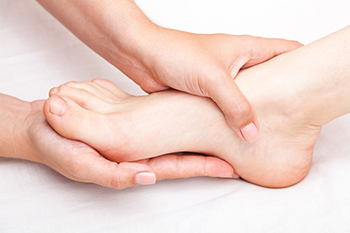
Podiatrists are doctors that are foot specialists, meaning that they are well versed in diagnosing and treating afflictions of the human foot. Although one day can look different from another for a podiatrist, there are certain tasks that podiatrists might perform every day. For example, a podiatrist might perform a surgical procedure to address problems like ingrown nails, bunions, corns, and so much more. On a typical day, a podiatrist might also provide advice to a patient about foot care techniques that they can incorporate into their daily lives. Podiatrists also spend a portion of their workdays performing diagnoses for patients. These diagnoses can be performed by examining a patient’s medical history or by obtaining imaging tests like X-rays. If you have a foot condition or questions about the health of your feet, reach out to a podiatrist today.
If you are experiencing pain in the feet or ankles, don’t join the stubborn majority refusing treatment. Feel free to contact one of our podiatrists from James Kutchback, DPM, CWS-P. Our doctors can provide the care you need to keep you pain-free and on your feet.
What Is a Podiatrist?
Someone would seek the care of a podiatrist if they have suffered a foot injury or have common foot ailments such as heal spurs, bunions, arch problems, deformities, ingrown toenails, corns, foot and ankle problems, etc.
Podiatric Treatment
A podiatrist will treat the problematic areas of the feet, ankle or lower leg by prescribing the following:
- Physical therapy
- Drugs
- Orthotic inserts or soles
- Surgery on lower extremity fractures
A common podiatric procedure a podiatrist will use is a scanner or force plate which will allow the podiatrist to know the designs of orthotics. Patients are then told to follow a series of tasks to complete the treatment. The computer will scan the foot a see which areas show weight distribution and pressure points. The podiatrist will read the analysis and then determine which treatment plans are available.
If you have any questions, please feel free to contact our offices located in The Woodlands and Woodville, TX . We offer the newest diagnostic and treatment technologies for all your foot care needs.
Can Gout Attacks Be Prevented?
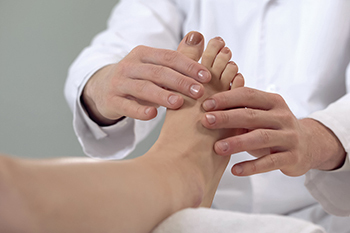
Patients who experience gout attacks are often familiar with the debilitating pain they can cause. Gout occurs as a result of crystals that form in the joints of the big toe and can develop for various reasons. Genetics can contribute significantly to the development of gout, in addition to having an abnormal metabolism that produces excess uric acid. It is seen in the joints of the body as crystals and can produce extreme pain and discomfort. This may come from eating foods that have high levels of purines like shellfish, red meat, and drinks that are made with large amounts of sugar. Drinking excess alcohol may also lead to gout so it is beneficial to drink in moderation. Gout attacks may be prevented by drinking plenty of water daily, consuming healthy foods, and practicing a gentle exercise program. Gout patients should be under the care of a podiatrist. It is strongly advised that you contact a podiatrist who can provide effective prevention techniques as well as treatments that are best for you.
Gout is a foot condition that requires certain treatment and care. If you are seeking treatment, contact one of our podiatrists from James Kutchback, DPM, CWS-P. Our doctors will treat your foot and ankle needs.
What Is Gout?
Gout is a type of arthritis caused by a buildup of uric acid in the bloodstream. It often develops in the foot, especially the big toe area, although it can manifest in other parts of the body as well. Gout can make walking and standing very painful and is especially common in diabetics and the obese.
People typically get gout because of a poor diet. Genetic predisposition is also a factor. The children of parents who have had gout frequently have a chance of developing it themselves.
Gout can easily be identified by redness and inflammation of the big toe and the surrounding areas of the foot. Other symptoms include extreme fatigue, joint pain, and running high fevers. Sometimes corticosteroid drugs can be prescribed to treat gout, but the best way to combat this disease is to get more exercise and eat a better diet.
If you have any questions, please feel free to contact our offices located in The Woodlands and Woodville, TX . We offer the newest diagnostic and treatment technologies for all your foot care needs.
The Diagnosis of Cuboid Syndrome
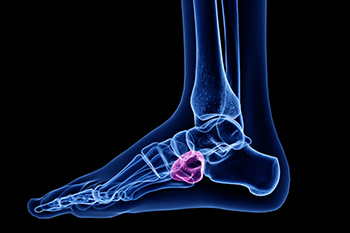
Having a physical examination performed is often an effective method to properly diagnose cuboid syndrome. This is done by applying direct pressure over the cuboid bone. A limited range of motion is often easy to notice. Pain on the outside of the foot and possibly extending to the ankle and toes may bring the patient in for an examination, and the midtarsal supination test is often performed. This consists of flexing the ankle and putting pressure on the cuboid bone. Common symptoms that are associated with this condition include intense pain, inflammation, and swelling. Relief may be found when the foot is wrapped with a protective covering that may help to provide stability as daily activities are accomplished. Despite the urge to keep moving, frequently elevating and resting the foot is beneficial as the healing process occurs. If you have pain in this part of your foot, please contact a podiatrist who can perform a proper diagnosis using the most effective methods, in addition to guiding you toward treatment techniques that are best for you.
Cuboid syndrome, also known as cuboid subluxation, occurs when the joints and ligaments near the cuboid bone in the foot become torn. If you have cuboid syndrome, consult with one of our podiatrists from James Kutchback, DPM, CWS-P. Our doctors will assess your condition and provide you with quality foot and ankle treatment.
Cuboid syndrome is a common cause of lateral foot pain, which is pain on the outside of the foot. The condition may happen suddenly due to an ankle sprain, or it may develop slowly overtime from repetitive tension through the bone and surrounding structures.
Causes
The most common causes of cuboid syndrome include:
- Injury – The most common cause of this ailment is an ankle sprain.
- Repetitive Strain – Tension placed through the peroneus longus muscle from repetitive activities such as jumping and running may cause excessive traction on the bone causing it to sublux.
- Altered Foot Biomechanics – Most people suffering from cuboid subluxation have flat feet.
Symptoms
A common symptom of cuboid syndrome is pain along the outside of the foot which can be felt in the ankle and toes. This pain may create walking difficulties and may cause those with the condition to walk with a limp.
Diagnosis
Diagnosis of cuboid syndrome is often difficult, and it is often misdiagnosed. X-rays, MRIs and CT scans often fail to properly show the cuboid subluxation. Although there isn’t a specific test used to diagnose cuboid syndrome, your podiatrist will usually check if pain is felt while pressing firmly on the cuboid bone of your foot.
Treatment
Just as the range of causes varies widely, so do treatments. Some more common treatments are ice therapy, rest, exercise, taping, and orthotics.
If you have any questions, please feel free to contact our offices located in The Woodlands and Woodville, TX . We offer the newest diagnostic and treatment technologies for all your foot care needs.
Why People May Hide Their Feet

Many people often neglect the care of their feet during the winter months. This may lead to reluctance in purchasing summer shoes, and having exposed feet at the beach or at the pool. There are simple everyday foot care practices that can alleviate the need to hide the feet. These include washing and drying the feet daily, followed by using a good moisturizer. Additionally, it is beneficial to properly have the nails trimmed regularly by cutting them at an angle. This may help to reduce the risk of developing an ingrown toenail. The feet will generally feel good when the correct size shoes are worn, which is determined by properly measuring the feet. It is suggested to keep the feet as dry as possible, which may help to prevent a fungal infection from starting. If you would like more information about the importance of and how to practice an effective foot care routine, it is suggested that you consult with a podiatrist who can answer any questions you may have.
Everyday foot care is very important to prevent infection and other foot ailments. If you need your feet checked, contact one of our podiatrists from James Kutchback, DPM, CWS-P. Our doctors can provide the care you need to keep you pain-free and on your feet.
Everyday Foot Care
Often, people take care of their bodies, face and hair more so than they do for their feet. But the feet are a very important aspect of our bodies, and one that we should pay more attention to. Without our feet, we would not be able to perform most daily tasks.
It is best to check your feet regularly to make sure there are no new bruises or cuts that you may not have noticed before. For dry feet, moisturizer can easily be a remedy and can be applied as often as necessary to the affected areas. Wearing shoes that fit well can also help you maintain good foot health, as well as making it easier to walk and do daily activities without the stress or pain of ill-fitting shoes, high heels, or even flip flops. Wearing clean socks with closed shoes is important to ensure that sweat and bacteria do not accumulate within the shoe. Clean socks help to prevent Athlete’s foot, fungi problems, bad odors, and can absorb sweat.
If you have any questions, please feel free to contact our offices located in The Woodlands and Woodville, TX . We offer the newest diagnostic and treatment technologies for all your foot care needs.
Swollen Feet and Salt
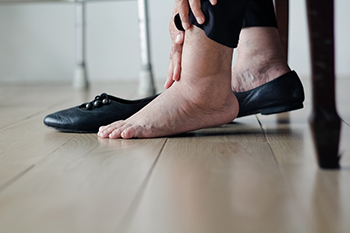
Swollen feet occur when your feet increase in size due to a concentration of fluids in the feet. It can also commonly impact the ankles. There are many different causes of swollen feet. For example, pregnancy, injuries, insect bites, and infections are just some of the many potential causes of swollen feet. However, one cause of swollen feet that is sometimes overlooked is high salt intake. A diet that is high in salt facilitates the retention of water in the body, which can ultimately cause swollen feet. To prevent this from occurring, an individual might consider adjusting their diet. Not only can one reduce their salt intake by not using salt shakers, but avoiding packaged/processed foods that are high in salt can also be helpful. Salt can be frequently found in these packaged foods as a kind of preservative. You might also consider reducing the number of processed meats that you consume, as some of these meats are high in salt as well. Salt substitutes such as potassium iodide might also be worth incorporating into your diet to limit salt intake. As with anything, it is always best to consult first with a medical professional. If you have swollen feet and believe that it might be linked to your salt intake, schedule an appointment with a podiatrist today.
Swollen feet can be a sign of an underlying condition. If you have any concerns, contact one of our podiatrists of James Kutchback, DPM, CWS-P. Our doctors can provide the care you need to keep you pain-free and on your feet.
Swollen feet are a common ailment among pregnant women and people who stand or sit for extended periods. Aging may increase the possibility of swollen feet and patients who are obese often notice when their feet are swelling too. There may be medical reasons why swollen feet occur:
- Phlebitis - A condition that causes the veins to become inflamed and can also cause leg pain.
- Liver disease - This may lead to low blood levels of albumin which is a protein. This can cause fluid in the blood to pass into the tissues and several areas of the body can become swollen.
- Heart failure - When the heart doesn’t pump properly the blood that is normally pumped back to the heart can pool in the veins of the legs causing swollen feet.
- Kidney disease - One of the main functions of the kidneys is releasing excess fluid in the body. This type of condition can make it difficult for the kidneys to function properly, and as a result the feet may become swollen.
- Deep-vein thrombosis (DVT)- This is a serious condition where blood clots form in the veins of the legs. They can block the return of blood from the legs to the heart which may cause the feet to swell. It is important to be treated by a podiatrist if this condition is present.
Swollen feet can also be caused by bone and tendon conditions, including fractures, arthritis, and tendinitis. Additionally, there may be skin and toenail conditions and an infection may cause the feet to swell. Patients who take medicine to treat high blood pressure may be prone to getting swollen feet.
Many patients elevate their feet to help relieve the swelling and this is generally a temporary remedy. When a podiatrist is consulted the reason behind the swelling can be uncovered and subsequently treated.
If you have any questions please contact our offices located in The Woodlands and Woodville, TX . We offer the newest diagnostic and treatment technologies for all your foot and ankle needs.
Treating Toenail Fungus
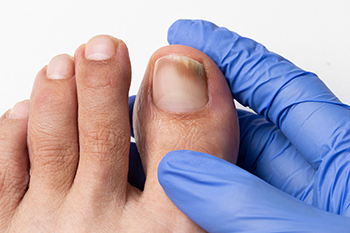
Onychomycosis, also called tinea unguium, is a fungal infection affecting the nails. Fungi thrive in warm, moist environments which can cause them to overpopulate. The same fungi that cause jock itch, athlete’s foot, and ringworm can cause nail infections. Such an infection might present itself as yellow or white spots on the toenail, the nail may raise from the nail bed, the skin surrounding the affected toenail may darken, the nail can become brittle and thick, and there may be a foul odor. Complications can arise from toenail fungus, so early intervention is suggested. Toenail fungus is contagious as well. It can spread between nails, onto the skin, and to other people. If you have any of these symptoms, see a podiatrist for a proper diagnosis. Fungal infections can mimic symptoms of other conditions. Once confirmed, a podiatrist will be able to recommend treatment for your specific toenail issue.
For more information about treatment, contact one of our podiatrists of James Kutchback, DPM, CWS-P. Our doctors can provide the care you need to keep you pain-free and on your feet.
Toenail Fungus Treatment
Toenail fungus is a condition that affects many people and can be especially hard to get rid of. Fortunately, there are several methods to go about treating and avoiding it.
Antifungals & Deterrence
Oral antifungal medicine has been shown to be effective in many cases. It is important to consult with a podiatrist to determine the proper regiment for you, or potentially explore other options.
Applying foot powder on the feet and shoes helps keep the feet free of moisture and sweat.
Sandals or open toed shoes – Wearing these will allow air movement and help keep feet dry. They also expose your feet to light, which fungus cannot tolerate. Socks with moisture wicking material also help as well.
If you have any questions please contact our offices located in The Woodlands and Woodville, TX . We offer the newest diagnostic and treatment technologies for all your foot and ankle needs.
Preventing Athlete’s Foot
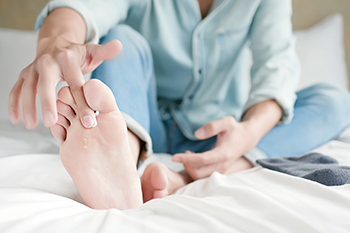
Athlete’s foot is a common infection that can affect a wide range of individuals. This fungal infection is caused by ringworm, and it can be spread by walking barefoot on highly trafficked public surfaces like pool sides. It is important to note that the fungus causing ringworm thrives in environments that are both warm and moist which is why athlete’s foot is often developed after walking barefoot in public locker rooms. There are several steps you can take to avoid developing athlete’s foot. First, you might consider wearing socks, shoes, or slippers when walking around the house. If a member of your household has athlete’s foot, the infection can be spread to others through bath mats, floors, and other surfaces. Second, it might be wise to wash and disinfect items that make frequent contact with the feet. Namely, you could diligently wash any towels, socks, or sheets that encountered another person’s bare feet. If you believe that you have athlete’s foot or want to learn more about methods of prevention, contact a podiatrist.
Athlete’s foot is an inconvenient condition that can be easily reduced with the proper treatment. If you have any concerns about your feet and ankles, contact one of our podiatrists from James Kutchback, DPM, CWS-P. Our doctors will treat your foot and ankle needs.
Athlete’s Foot: The Sole Story
Athlete's foot, also known as tinea pedis, can be an extremely contagious foot infection. It is commonly contracted in public changing areas and bathrooms, dormitory style living quarters, around locker rooms and public swimming pools, or anywhere your feet often come into contact with other people.
Solutions to Combat Athlete’s Foot
- Hydrate your feet by using lotion
- Exfoliate
- Buff off nails
- Use of anti-fungal products
- Examine your feet and visit your doctor if any suspicious blisters or cuts develop
Athlete’s foot can cause many irritating symptoms such as dry and flaking skin, itching, and redness. Some more severe symptoms can include bleeding and cracked skin, intense itching and burning, and even pain when walking. In the worst cases, Athlete’s foot can cause blistering as well. Speak to your podiatrist for a better understanding of the different causes of Athlete’s foot, as well as help in determining which treatment options are best for you.
If you have any questions please feel free to contact our offices located in The Woodlands and Woodville, TX . We offer the newest diagnostic and treatment technologies for all your foot and ankle needs.






